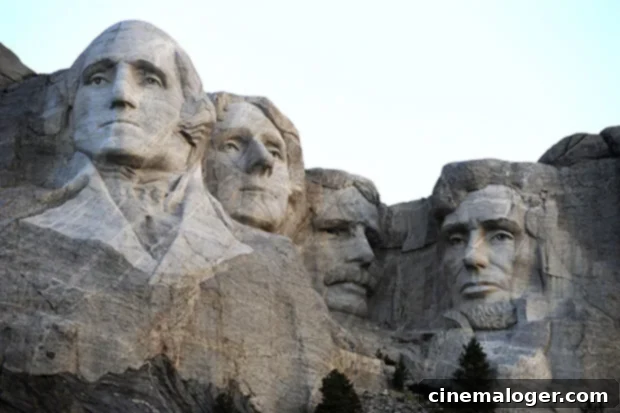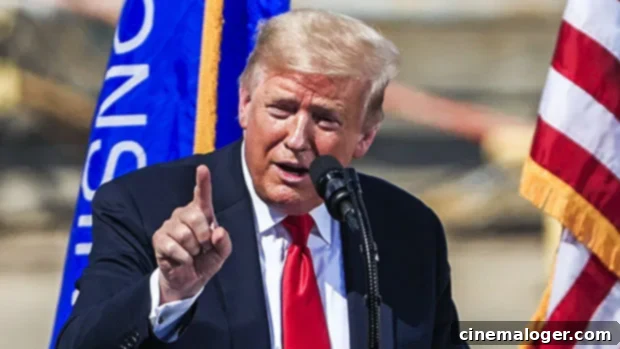Donald Trump’s Mount Rushmore Speech Unveils ‘National Garden of American Heroes’ Amidst Widespread Public Backlash and Deep-Seated Controversies
In a controversial address delivered at Mount Rushmore on July 3rd, then-President Donald Trump announced his ambitious plan to create a “National Garden of American Heroes,” a sprawling park intended to feature statues celebrating the nation’s most revered figures. The announcement, made just ahead of Independence Day celebrations, was met with a swift and largely critical reaction across social media platforms, particularly on Twitter. Users questioned the timing and priorities of such a project, with many highlighting the ongoing challenges posed by the COVID-19 pandemic and the broader calls for social justice that had dominated public discourse.
President Donald Trump’s speech, delivered against the iconic backdrop of the 60-foot granite faces of four American presidents, aimed to project an image of national strength and unwavering patriotism. However, his proposal for a “national garden” filled with statues of American “heroes” quickly ignited a firestorm of online commentary. Critics argued that the focus should instead be on addressing the pressing public health crisis and economic fallout from COVID-19. One Twitter user succinctly captured this sentiment, writing, “Won’t do anything about the Coronavirus, but will build a park of statues.” The irony was not lost on many, who saw the initiative as a distraction from more immediate and critical national concerns.
The online ridicule extended to sarcastic suggestions for who might be included in such a garden. Humorous and often biting suggestions quickly circulated, reflecting a cynical view of who might be deemed a “hero” by the administration. One widely shared joke envisioned “The National Garden Of American Heroes” featuring contemporary pop culture figures like “Kid Rock, Kim Kardashian, Kanye West, and Ted Nugent,” underscoring the perceived absurdity of the project and the divisive nature of celebrity culture often associated with the Trump era.
The National Garden of American Heroes: Kid Rock, Kim Kardashian, Kanye West, and Ted Nugent.
— Will Harris (@NonStopPop) July 4, 2020
Beyond sarcasm, many reactions expressed genuine outrage and a call for re-prioritization. “How about a national garden dedicated to all the Americans lost to COVID-19? #ExecutiveOrder,” one tweet suggested, directly linking the project to the tragic human cost of the pandemic. Another user echoed this sentiment with a stark question: “The national garden of American heroes? WTH is this trivial sh*t? How about focusing on a pandemic that has already killed >129,000 Americans.” The sentiment was clear: a park of statues felt tone-deaf and insignificant in the face of a rapidly escalating national crisis. The exasperation was further highlighted by a sarcastic yet pointed comment: “Just what Americans need right now: a statue park.” These reactions painted a picture of a nation grappling with profound challenges, where symbolic gestures were often perceived as inadequate or misplaced.
https://twitter.com/SnarkandMeh/status/1279257242756354048?s=20
During his speech, President Trump also took the opportunity to address the ongoing national debate surrounding historical monuments and the broader “cancel culture” movement. He passionately defended existing monuments, including Mount Rushmore itself, vowing that they would “never be desecrated” by what he described as “angry mobs” attempting to “tear down statues.” This rhetoric was a clear response to the wave of monument vandalism and removals that occurred during the Black Lives Matter protests, which sought to challenge statues of figures associated with slavery, colonialism, or other controversial historical actions. Trump positioned himself as a staunch defender of American heritage, arguing that these monuments represented the nation’s foundational values and should be preserved against what he termed “totalitarianism” inherent in “cancel culture.”
Won’t do anything about the Coronavirus, but will build a park of statues. https://t.co/XzkzkucMhG
— Dan of Ritz-Carlton Sprinklers (@JakesForLuck) July 4, 2020
“Angry mobs are trying to tear down statues of our founders,” Trump declared to the cheering crowd. “The American people are strong and proud, and they will not allow our country and all of its values, history, and culture to be taken from them. One of their political weapons is cancel culture… that is the very definition of totalitarianism. It has no place in the United States of America.” His speech emphasized a narrative of defending traditional American identity against what he characterized as radical attempts to rewrite history and erase national symbols. This stance resonated with his base, but further alienated those who felt the monuments represented painful historical injustices.
The Independence Day weekend event also marked the revival of fireworks over Mount Rushmore, a spectacle that had been banned for a decade due to significant environmental concerns during the Obama administration. Trump, a vocal proponent of reinstating the pyrotechnic display, delivered his speech framed by the monumental granite carvings of Presidents George Washington, Thomas Jefferson, Abraham Lincoln, and Theodore Roosevelt. He meticulously recounted stories of each president’s contributions to American history, ensuring their legacy was interwoven with his message of national strength and pride, further cementing the symbolism of the location for his political agenda.
The decision to proceed with the fireworks, despite environmental warnings, added another layer of controversy to the event. The National Park Service had previously cited substantial risks of wildfires in the surrounding Ponderosa pine forest, particularly given the Black Hills region was experiencing a drought at the time. Historical data supported these concerns, with at least 27 wildfires reported around Mount Rushmore between 1998 and 2009. While Trump dismissed these fears by asserting it was “just rock,” environmental experts cautioned that the monument is encircled by abundant vegetation, making the area highly susceptible to ignition from fireworks, especially during periods of high to very high fire danger in July. The potential for ecological damage and public safety risks, therefore, was a major point of contention.
Just what Americans need rights now: a statue park
— Kassevy (@kassevy) July 4, 2020
Further compounding the criticism was the sheer scale of the event in the midst of a global pandemic. Over 7,000 spectators gathered for the speech and fireworks display, with virtually no provisions for social distancing. This disregard for public health guidelines came at a time when South Dakota alone had recorded 91 COVID-19 related deaths, and health experts were urging caution against large public gatherings. Critics widely condemned the event as a dangerous superspreader risk, questioning the administration’s commitment to public safety and its acknowledgment of the severity of the virus, especially after the President’s own administration had urged citizens to wear masks and maintain physical distance. This perceived disconnect between rhetoric and action fueled public frustration and anxiety.
Perhaps the most profound and deeply rooted controversy surrounding the Mount Rushmore event was its location on land historically belonging to the Lakota Sioux Nation. The monument itself, a monumental carving on sacred Black Hills land, has long been a symbol of injustice for Native American tribes. The event proceeded without the explicit permission or consultation of the tribal nations who legally claim the territory. Native Americans, including citizens of the Oglala Lakota Nation, accused President Trump and South Dakota Governor Kristi Noem of violating the 1868 Fort Laramie Treaty. This foundational treaty unequivocally recognized Mount Rushmore and its surrounding areas as part of “the Great Sioux Reservation, set aside for exclusive use by the Sioux people.”
A landmark 1980 Supreme Court ruling reaffirmed the binding nature of the Fort Laramie Treaty, acknowledging that the United States had illegally taken the Black Hills from the Sioux. Despite the Court offering monetary compensation, the Sioux Nation has consistently refused it, demanding the return of their ancestral lands instead. Nick Tilsen, a prominent citizen of the Oglala Lakota Nation and president of NDN Collective, articulated the gravity of the situation to NPR: “We’re at a time in this country where there’s a reckoning and a realization that this country has to get right with its history. That’s why this is not just a historical injustice that has happened — it’s illuminating the current injustices that exist today in society.” As a direct consequence of these unresolved land claims and the perceived disrespect, the event was met with organized protests from the Lakota Nation, who blocked roads leading to the monument, emphasizing the profound and ongoing struggle for indigenous rights and historical recognition. The Mount Rushmore speech, therefore, inadvertently shone a spotlight on America’s fraught relationship with its own past, particularly concerning its indigenous peoples.

Ultimately, Donald Trump’s Mount Rushmore address and the subsequent “National Garden of American Heroes” proposal became a microcosm of the political and social tensions gripping the United States in mid-2020. While intended to project strength and unity, the event instead amplified deep divisions concerning national priorities, historical interpretation, environmental responsibility, and indigenous rights. From the immediate backlash on social media over perceived misallocation of resources during a pandemic, to the rekindling of environmental concerns with fireworks, and most significantly, the ongoing historical injustice against Native American tribes, the celebration of American heroism at Mount Rushmore was anything but straightforward. It underscored the complex, often contradictory narratives that define American identity and its contested history, making it a highly debated moment in contemporary political discourse.
